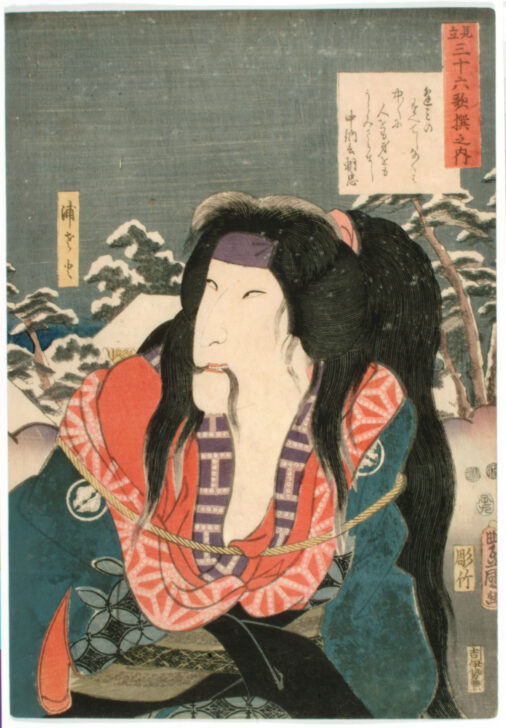Actors Compared with the Thirty Six Poetic Immortals: Bandō Shūka I as Urazato
Utagawa Kunisada

Description
In this series of prints, Toyokuni III (Kunisada) depicts popular kabuki actors against landscape backgrounds, and adds a cartouche with the name and a poem by one of the so-called "thirty-six poetic immortals," a selection of classical poets. The actors are identified only by the role and not by name, as actor prints had been forbidden in recent regulation. To a contemporary audience, of course, the actors would have been immediately recognizable by their physiognomies or actor's crests. Today, we can reconstruct the names of many, but not all, of the actors in the series.
This print depicts an unidentified actor is in the role of the courtesan Urazato of the Yamanaya. She had been beated with a broom by her employer, and tied to a tree in the snow. She has just been rescued by her lover Tokijirô, but is still bound by the rope.
The entire series is illustrated online at http://62.238.34.70/toshidama/prints.stm
Subject Matter:
The Thirty Six Poetic Immortals are a selection of classical poets known for their skills. The selection is from the Heian period (794-1185) or earlier. This print references 10th century statesman Fujiwara Asatada.
Actor Bandō Shūka I also held the name Bandō Mitsugorō V. He was born in 1813 and active from 1824 until shortly before his death in 1854. He was known for both period and contemporary plays and for his portrayal of young onnagata, a word that means “female form” or “female role”. In this print, he is depicted as the Yamana courtesan from the play Akegarasu hana no nureginu.
The artist, Utagawa Toyokuni III, was notable for creating images of actors in which specific individuals were identifiable. Not only were these popular actors recognizably depicted for fan consumption through these prints, but they were associated both with the poet immortals and specific flowers, each of which had special meanings in Edo society. Such layered meanings are hallmarks of mitate (literally meaning look and compare) prints. Mitate images were usually indicated by the use of the word mitate in the title, though it sometimes was omitted and viewers were meant to puzzle it out. This genre often juxtaposed contemporary figures such as kabuki actors with historical figures such as the poet immortals. Edoites enjoyed these layered meanings and would have made the connection between this series and the poet immortals with relative ease.
Physical Description:
In this picture, a woman is bound by a chord of rope around her shoulders. Her hair is dishevelled, and a piece of it is clamped in her mouth. She looks off to her right. Snow-covered trees emerge from the background against a dark sky.
Inscriptions: Mitate sanjūrokkasen no uchi; Urazato; Censors' seal: Hama & Magome; ne 9; Artist's signature: Toyokuni ga; Carver's seal: Horitake; Publisher's seal: Kichi, Isekane
Usage Rights:
If you are interested in using an image for a publication, please visit https://umma.umich.edu/request-image/ for more information and to fill out the online Image Rights and Reproductions Request Form.